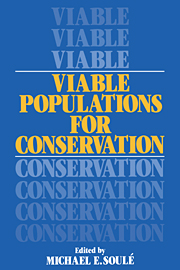Book contents
- Frontmatter
- Contents
- List of contributors
- Preface
- 1 Introduction
- 2 The demography of chance extinction
- 3 Extinction models and mammalian persistence
- 4 Minimum viable population size in the presence of catastrophes
- 5 Minimum viable populations: coping with uncertainty
- 6 Effective population size, genetic variation, and their use in population management
- 7 Spatial structure and population vulnerability
- 8 Managing critically endangered species: the Sumatran rhino as a case study
- 9 The role of interagency cooperation in managing for viable populations
- 10 Where do we go from here?
- Index
8 - Managing critically endangered species: the Sumatran rhino as a case study
Published online by Cambridge University Press: 21 January 2010
- Frontmatter
- Contents
- List of contributors
- Preface
- 1 Introduction
- 2 The demography of chance extinction
- 3 Extinction models and mammalian persistence
- 4 Minimum viable population size in the presence of catastrophes
- 5 Minimum viable populations: coping with uncertainty
- 6 Effective population size, genetic variation, and their use in population management
- 7 Spatial structure and population vulnerability
- 8 Managing critically endangered species: the Sumatran rhino as a case study
- 9 The role of interagency cooperation in managing for viable populations
- 10 Where do we go from here?
- Index
Summary
The saving of critically endangered species is costly, and it is likely to conflict with other societal objectives. Methods are needed for clarifying and resolving such conflicts. In this chapter we will discuss an analytical tool called decision analysis (Raiffa, 1968). Decision analysis provides an explicit framework for identifying species in immediate danger of extinction, defining cases that may require intervention, evaluating the risks and benefits of alternate management strategies, and assessing whether or not the management efforts required to prevent a species' extinction can be justified in terms of their costs to society.
Why is an explicit framework needed? Conservation biology is essentially a crisis discipline (Soulé, 1985); neither time nor abundant economic resources are on its side. Difficult choices often must be made, usually in the absence of adequate data. When the outcomes of alternate actions are uncertain, it is hard to anticipate intuitively which one will be best. Furthermore, there are often several criteria for evaluating outcomes, such as minimizing costs versus maximizing protection; one action may seem to be best under the former criterion but a second far more desirable under the latter. Decision analysis provides a means of evaluating alternatives in a logical and repeatable manner; it is also a useful tool for communicating alternate management plans to others so that they can be persuaded to endorse one or more of them.
- Type
- Chapter
- Information
- Viable Populations for Conservation , pp. 141 - 158Publisher: Cambridge University PressPrint publication year: 1987
- 20
- Cited by



